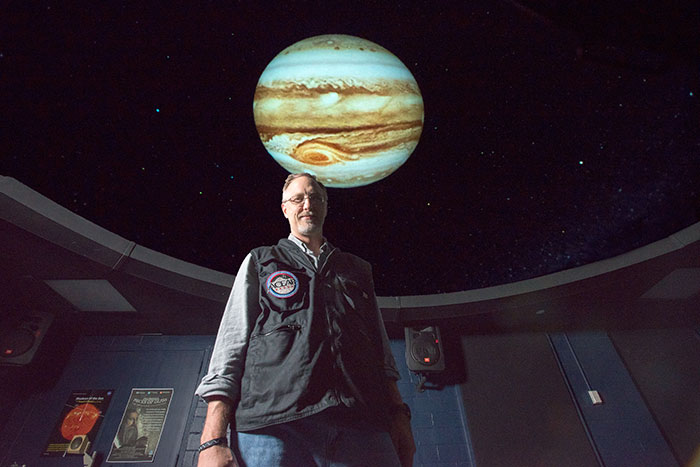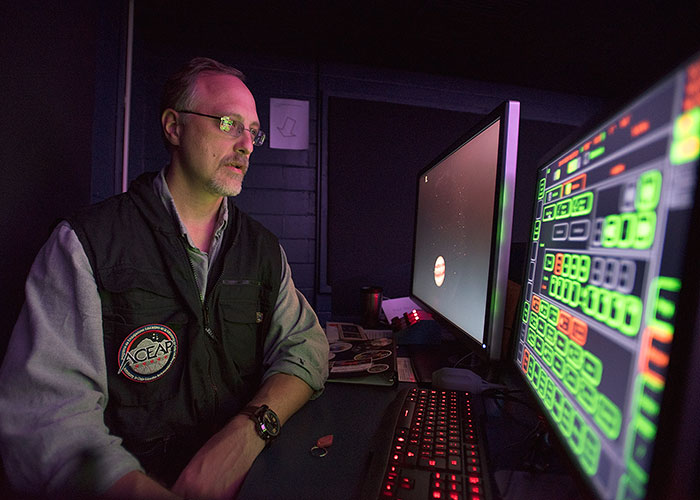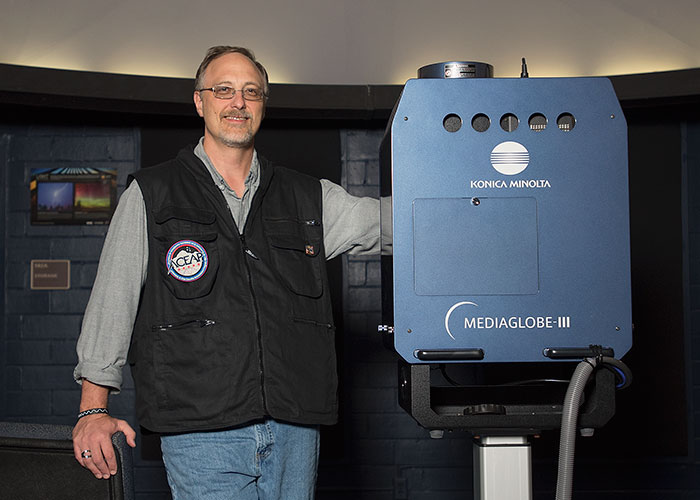Today@Sam Article
Amateur Astronomer Reaches For Stars As Ambassador In Chile
Oct. 30, 2015
SHSU Media Contact: Chelsea Keller
 |
| In addition to teaching physics labs at the SHSU Observatory, Michael Prokosch has presented "star shows" in the SHSU Planetarium (above), on the first floor of the Farrington Building, since 2001. These monthly short films explore various elements of astronomy. A schedule of upcoming events is available here. —Photos by Brian Blalock |
When Michael Prokosch graduated from Sam Houston State University with a bachelor’s degree in history, he never imagined that he would end up working as an amateur astronomer.
After graduating, Prokosch began teaching special education in the Huntsville area. However, astronomy is an area that has interested him since he was 6 years old, and throughout the years, his interest has become a passion.
This passion brought him back to SHSU in 2001.
“Mars was going to be in opposition, which means Mars would be on the opposite side of the sky from the sun as seen from Earth,” Prokosch said. “I sent an email to random people in the physics department and Dr. (physics professor Renee) James got back to me and said, ‘Yeah, sure. Come on over and bring your telescope.’”
It was the beginning of a beautiful relationship between Prokosch and the physics department. Following this interaction, he was offered a part-time position as a “lab assistant,” though his duties have stretched further than just working in labs.
 |
| Last year, the Planetarium received state-of-the-art technology upgrades that allow for higher resolution, a higher contrast ratio, 3-D space simulation, and special effects during the presentations. |
 |
During the long semesters, Prokosch keeps the SHSU Observatory open two nights a week to teach astronomy students. He also holds star shows in the SHSU Planetarium a few times a month for the public.
“Mike is, without a doubt, the single biggest reason that we have such an active Observatory and Planetarium here at SHSU,” James said. “His enthusiasm for the subject and his desire to convey astronomy to the public are contagious.”
Because of his work with the SHSU Planetarium, Prokosch received an invitation from the Museum Alliance to apply for the Astronomy in Chile Educators and Ambassador Program, an opportunity that would allow him to fuel his passion, and his knowledge, of astronomy.
He was selected as one of nine ambassadors from the United States, which included funding from the National Science Foundation for his lodging and meals.
When Prokosch arrived in Chile, his notion that “Chile was the place to be for astronomy” was immediately realized; Chileans wear their love of astronomy on their sleeves and have adapted a way of life that promotes the study of space and the sky.
“Immediately after landing in La Serena, you see a sign that says ‘Ruta De Las Estrellas,’ which means ‘Road of the Stars,’” Prokosch said.
Not only does Chile have the right attitude, but also the right altitude; because of its favorable location, Chile has about 40 percent of all the telescopes in the world, and by 2025 they will have 70 percent, according to Prokosch.
“The government and the citizens of Chile passed a national ordinance for light pollution. Because of this, you can drive 15 minutes out of the city of Santiago, and you can see the Milky Way with your naked eye,” Prokosch said. “All the street lights, parking lot lights, etc., are pointed down so they’re lighting up the streets, not pointing up to light the night sky.”
During his visit, Prokosch was able to see the largest set of telescopes in the world, including the Atacama Large Millimeter Array, an international partnership of the some of the world’s most prestigious scientific organizations that sits at an altitude of 16,500 feet.
“To go up that high in altitude, you have to acclimate your body. We spent a couple days at the Cerro Tololo Inter-American Observatory, which is at 7,000 feet, and then at Gemini (Observatory), at 9,000 feet,” Prokosch said. “When you get up to the last plateau, you have to pass a physical.”
Being that high is dangerous for the body, so there are strict rules that allow the researchers to spend only six hours past the place of departure and require that their vitals be constantly monitored. Visitors are only allowed to stay two hours. There also are ambulances that follow them around.
A 'Chile' Experience |
“You get up there and it is very dry; if you can take all the water above your head at that point and tried to squish it into a puddle, the resulting puddle would only be 1/2 a millimeter thick,” Prokosch said. “There’s more air below you than there is above; from a certain perspective, you are halfway to space.”
Prokosch also was able to see the construction site of the Large Synoptic Survey Telescope, an 8-meter-wide telescope that will give the public access to the data it will collect.
“With this project, you will even be able to adopt a patch of sky; your teeny tiny chunk could have asteroids, comets, or even supernovas,” he said.
Aside from the access to an incredible view, participating in the ACEAP allowed Prokosch to form connections with astronomers from both Chile and the U.S. Ambassadors are required to go on a minimum of four public outreach activities back in the U.S., and as a group they are working on a book and a planetarium show.
“I went down to Chile to not only experience the astronomy and the night skies, but meet the people who are involved and experience the culture that the country has to offer,” Prokosch said.
Prokosch set up a blog to document his trip and keep those in his amateur astronomy club and community in the loop. Even after the trip, he has kept up with the blog and the SHSU Observatory. Prokosch also writes for the Huntsville Item.
In November, he will meet up with many of the ambassadors again at The National Radio Astronomy Observatory in Green Bank, West Virginia, to work on the book and planetarium show.
For more information on Prokosch or upcoming astronomy events, visit huntsvilleastronomy.org/seeing-stars-blog or follow him on twitter at @SHSUobservatory.
- END -
This page maintained by SHSU's Communications Office:
Director of Content Communications: Emily Binetti
Communications Manager: Mikah Boyd
Telephone: 936.294.1837
Communications Specialist: Campbell Atkins
Telephone: 936.294.2638
Please send comments, corrections, news tips to Today@Sam.edu
